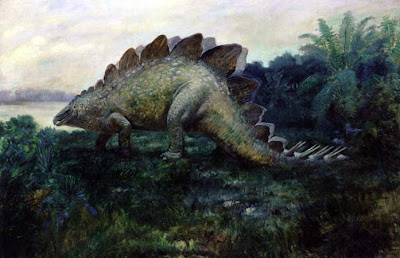Kong-blogging, essay 11 of 15 blog entries on
Skull Island in King Kong (1933)
Part One, The First Dinosaur Encounter
Part One, The First Dinosaur Encounter
 |
| The Stegosaurus in King Kong (1933). |
Enter Stegosaurus, stage left.*
Our first look at the Stegosaurus is over the shoulders of
the ship’s crew. The dinosaur enters a
clearing in the distance, oblivious to the men in the foreground.
 |
| Our first sight of the Stegosaurus in King Kong. |
There are at least five planes of depth visible at this
point. In the foreground, the actors
playing the crew are on a jungle-decorated studio set. Then (rear-projected) there’s a fairly
lengthy animation table, dressed with miniature trees, vines, and a log. Behind that is a matte painting on glass with
more jungle details. Then another
animation table behind which stands a painted canvas. That’s five levels, and I may have missed two glass paintings, possibly one in front of the background canvas and another closer to the foreground.
You look for the genius of King Kong within the shots—that’s
where the magic is. It’s in the way
birds fly across the screen, left to right, in the mid-ground, as that
Stegosaurus placidly enters the screen in the distance.
The planes of depth are not static.
There’s movement taking place on three of them.
 |
| The Stegosaurus re-emerges nearer to us. |
Action at one layer can even move to another. That distant Stegosaurus on the furthest
animation table wanders out of the frame (stage right) then emerges much nearer
to us, now on the middle animation table.
The Stegosaurus lazily munches on some plants (a nice example of the gratuitous
detail the movie loves to indulge in!) then sees the men.
“He’s going to charge,” shouts Carl Denham, the men’s leader.
 |
| The Stegosaurus charges. |
The line between the set decoration in the foreground (where
the actors are performing) and the rear-projected animation table is
beautifully hidden. The Stegosaurus
barrels forward, rapidly getting larger, filling much of the frame with his
bulk, before he’s finally brought down by a gas bomb tossed by Denham.
 |
| The dying Stegosaurus. |
The death throes of the Stegosaurus are masterfully
realized. Co-directors Merian C. Cooper
and Ernest B. Schoedsack had watched many animals die during their adventures
in various remote areas. I can imagine
them offering O’Brien advice on just how a large dying animal would act.
Even after the gas bomb explodes, the Stegosaurus still has
life in him. Denham shoots and the
dinosaur sways back onto its feet, only to collapse again. This time Denham shoots the Stegosaur in the
brain causing its head to jerk upward, quivering. As Denham and first mate Jack Driscoll walk alongside
the dying body of the immense beast, its tail still undulates as its life ebbs.
Some books have reported that Kong’s Stegosaurus may have
been an intentional cross between a traditional Stegosaurus and a Kentrosaurus
because of its unusual eight-spiked tail.
Stegosaurus is now known to have a four-spiked tail while its smaller cousin Kentrosaurus
has a whole series of spikes extending down its back to its tail. But famous paleontologist Othniel C. Marsh,
who described the first-discovered Stegosaurus in 1877, approved a drawing of a
Stegosaurus skeleton for the1896 U.S. Geological Survey that gave the giant
animal eight spikes on its tail. The
following year, acclaimed artist Charles R. Knight depicted Stegosaurus with
eight spikes, perhaps following Marsh’s lead. So
there may have been some scientific basis for the choice of eight spikes on the
Stegosaurus tail—and, artistically, they sure look impressive as the tail rises
and falls with a serpentine grace.
* Using classic stage directions, stage left refers to our thespian Stegosaurus’ left—the audience
sees the dinosaur enter from the right side of the screen.
Part Two, The
Eight-Spiked Stegosaurus
 |
| The eight-spiked tail of the Stegosaurus undulates as the dinosaur dies in King Kong. |
 |
| Eight-spiked illustration of Stegosaurus unngulatus approved by paleontologist Othniel C. Marsh for the 1896 U.S. Geological Survey. Source: Wikimedia Commons |
 |
| Charles R. Knight drawing of an eight-spiked Stegosaurus (1897). Source: Wikimedia Commons |
 |
| Charles R. Knight painting of an eight-spiked Stegosaurus (1912). Source: Wikimedia Commons |
The Making of King Kong by Orville Goldner and George E. Turner
Living Dangerously: The Adventures of Merian C. Cooper by Mark Cotta Vaz
Willis O'Brien: Special Effects Genius by Steve Archer
Dinosaurs Past and Present, Volume 1, Natural History Museum of Los Angeles County
Dinosaurs Past and Present, Volume 2, Natural History Museum of Los Angeles County
Charles R. Knight: The Artist Who Saw Through Time by Richard Milner
All in the Bones: A Biography of Benjamin Waterhouse Hawkins by Valerie Bramwell and Robert M. Peck
Special features on the two-disc special edition, King Kong (1933) by Warner Home Video Inc.
Special features on the two-disc special edition, King Kong (1933) by Warner Home Video Inc.
... and an occasional sneak glance at Wikipedia entries (but always double-checking everything!)
Watch King Kong...
Purchase a King Kong DVD or Blu-Ray set at Amazon or Barnes & Noble.
Rent King Kong at Netflix or other rental service.
© 2012 Lee Price
Rent King Kong at Netflix or other rental service.
© 2012 Lee Price

No comments:
Post a Comment